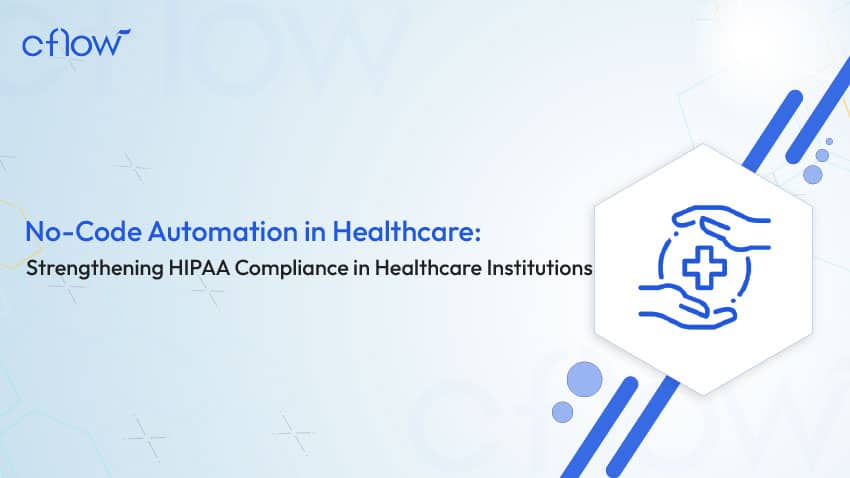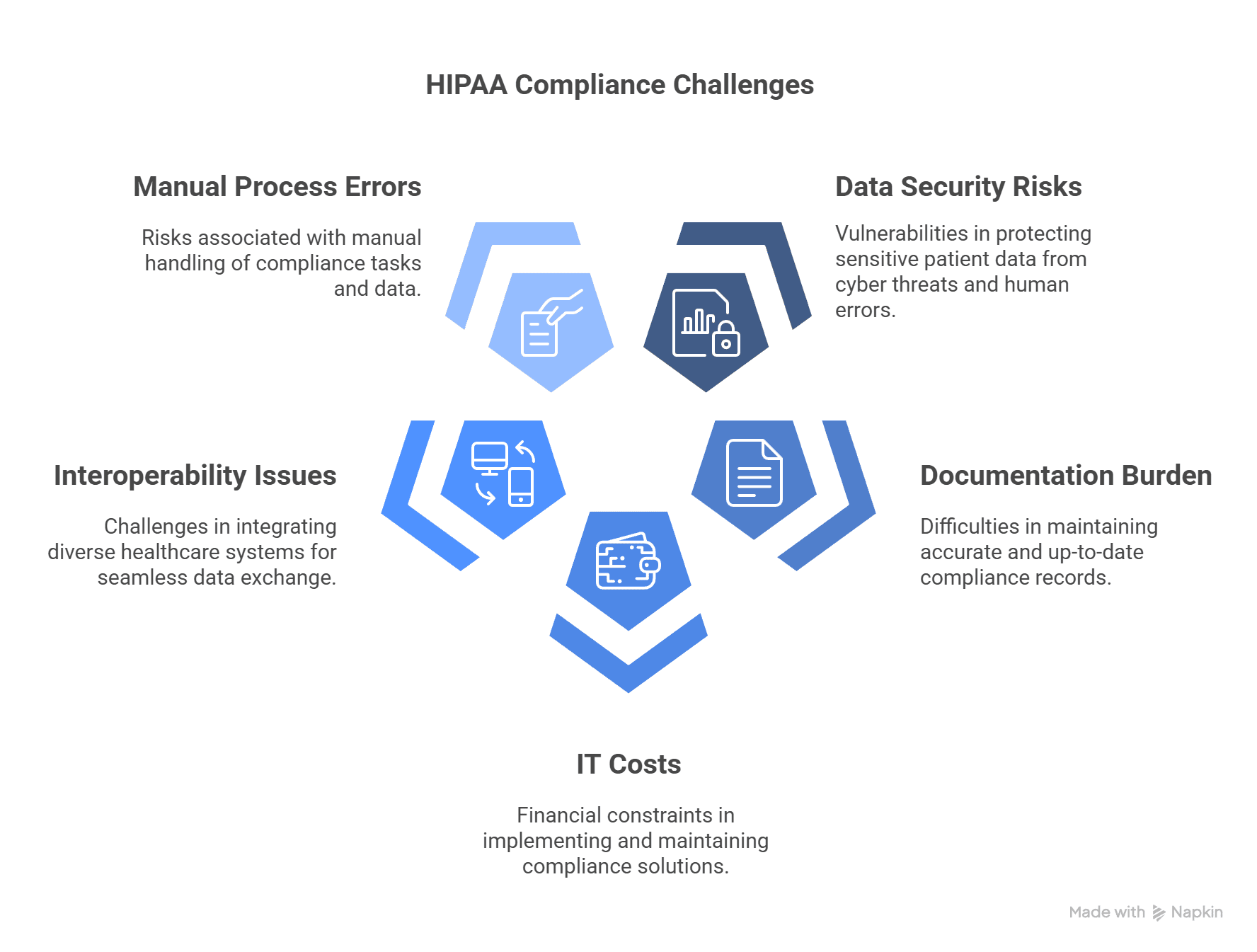No-Code Automation in Healthcare: Strengthening HIPAA Compliance in Healthcare Institutions

Key takeaways
- No-code automation in healthcare streamlines compliance workflows, reducing manual errors and enhancing HIPAA compliance efficiency.
- No-code workflows for HIPAA compliance help healthcare organisations secure patient data with automated access controls and encryption.
- Regulatory compliance with no-code tools ensures seamless audit trails, reducing the risk of HIPAA violations and compliance fines.
- No-code solutions for healthcare minimise IT dependency, allowing medical professionals to automate administrative tasks effortlessly.
The healthcare industry is under increasing pressure to comply with the Health Insurance Portability and Accountability Act (HIPAA) while ensuring efficiency in patient data management. Traditional compliance processes often involve time-consuming manual tracking, high operational costs, and increased risks of human errors.
With No-Code Automation in Healthcare, organisations can streamline compliance workflows, enhance security, and reduce manual errors. No-code workflows for HIPAA compliance allow healthcare providers to automate data management, patient recordkeeping, and compliance tracking without the need for extensive IT support.
This blog explores the significance of no-code automation in healthcare and its role in maintaining HIPAA compliance. It delves into how no-code workflows streamline compliance processes, the key healthcare operations that can be automated, and common mistakes to avoid when implementing automation. Additionally, it provides insights into secure implementation strategies, helping healthcare organisations leverage no-code solutions effectively.
Why UK Healthcare Providers Must Prioritise Compliance Automation
While HIPAA compliance applies primarily to the US, UK healthcare providers must adhere to similar data protection regulations such as the Data Protection Act 2018 and UK GDPR. NHS trusts, private practices, and care facilities all handle sensitive patient data and face increasing scrutiny around digital security and compliance. No-code automation offers a way to achieve these regulatory goals efficiently, without increasing IT overhead.
No-Code Automation for HIPAA Compliance
Ensuring HIPAA compliance is a critical priority for healthcare organisations, but manual processes often lead to errors, inefficiencies, and compliance risks. No-code automation offers a streamlined, secure, and scalable way to manage patient data, access controls, and regulatory reporting without complex coding. With automated workflows, healthcare providers can enforce encryption, monitor access logs, and generate real-time audit reports, reducing human intervention and ensuring compliance.
By integrating no-code workflow platforms, organisations can eliminate manual compliance bottlenecks, enhance data security, and maintain regulatory adherence effortlessly. As healthcare regulations evolve, no-code automation empowers teams to stay ahead of compliance requirements with minimal IT dependency.
How Does No-Code Differ from Traditional Healthcare Compliance Solutions?
Traditional IT Solutions | No-Code Solutions |
Require custom development and high IT dependency. | Allow non-technical users to build workflows easily. |
Expensive and time-consuming to implement. | Cost-effective and quick to deploy. |
Limited flexibility in workflow changes. | Easily customizable to meet evolving compliance needs. |
Why No-Code is a Game-Changer for Healthcare Organisations?
- Speeds up compliance workflows – No-code automation eliminates the need for IT intervention, allowing healthcare teams to streamline and manage compliance workflows independently.
- Automates regulatory documentation – Reduces human errors, ensures accurate data entry, and minimises compliance risks associated with manual recordkeeping.
- Enables secure patient data handling – Implements encryption, access controls, and automated audit trails to ensure HIPAA compliance while maintaining operational efficiency.
Why HIPAA Compliance is a Major Challenge in Healthcare
Ensuring HIPAA compliance is one of the biggest challenges for healthcare organisations due to the complex regulations surrounding patient data security and confidentiality. Non-compliance can result in severe legal consequences, financial penalties, and reputational damage. Many healthcare providers struggle with outdated manual processes, high compliance costs, and a lack of system interoperability, making it difficult to maintain HIPAA adherence efficiently.
According to the U.S. Department of Health & Human Services (HHS), there were 722 healthcare data breaches reported in 2022, exposing millions of patient records. Implementing automation can significantly reduce these challenges, but first, it’s important to understand the most pressing compliance obstacles healthcare organisations face today.
Understanding UK Healthcare Compliance: UK GDPR and NHS Digital
UK healthcare organisations must comply with the UK General Data Protection Regulation (UK GDPR) and NHS Digital’s Data Security and Protection Toolkit (DSPT). These frameworks require robust controls over patient data access, encryption, breach monitoring, and auditability. No-code workflow automation helps organisations align with these requirements by enforcing security policies, automating documentation, and providing real-time compliance visibility.
Understanding HIPAA Requirements
The Health Insurance Portability and Accountability Act (HIPAA) mandates strict regulations to protect patient information, ensuring data security, confidentiality, and compliance tracking. Healthcare organisations must implement robust measures to prevent unauthorised access, data breaches, and compliance failures. Failure to comply can lead to financial penalties of up to $1.5 million per violation, legal repercussions, and loss of patient trust.
Common HIPAA Compliance Challenges

Data Security & Unauthorised Access Risks –
Healthcare organisations handle vast amounts of sensitive patient information, making them prime targets for cyberattacks. Manual tracking of access logs and security breaches leaves systems vulnerable to unauthorised access, identity theft, and data breaches. Studies reveal that 43% of healthcare data breaches are attributed to human error, such as lost or stolen unencrypted devices and unintentional disclosures
Documentation & Compliance Reporting Burden –
Keeping up with HIPAA compliance requires meticulous record-keeping, tracking policy changes, and maintaining up-to-date documentation. Manual compliance tracking is time-consuming, error-prone, and often leads to missing records, increasing the risk of non-compliance penalties.
High Costs of IT-Managed Compliance Solutions –
Traditional compliance solutions often require expensive software, dedicated IT teams, and ongoing maintenance costs. Many healthcare providers struggle with budget constraints, making it difficult to invest in enterprise-level security and compliance platforms.
Lack of Interoperability Between Healthcare Systems –
Healthcare providers use multiple platforms for Electronic Health Records (EHR), billing, and patient management, but these systems often lack seamless integration. Manual data transfers between different systems increase security vulnerabilities, duplication errors, and compliance violations.
Error-Prone Manual Processes –
Manually handling compliance tasks, access controls, and audit logs creates room for human errors, data discrepancies, and inconsistencies in documentation. This not only slows down compliance workflows but also heightens regulatory risks.
How No-Code Automation Enhances HIPAA Compliance
Ensuring HIPAA compliance can be challenging with traditional manual processes. No-code automation offers secure, efficient, and scalable solutions to help healthcare organisations protect sensitive patient data while maintaining compliance with regulatory requirements. The risks of HIPAA non-compliance are immense. Between 2009 and 2020, over 2,500 healthcare data breaches led to 385 million exposed medical records. Automating HIPAA workflows with no-code solutions ensures real-time compliance tracking and minimises human errors that lead to such breaches.
By automating security measures, data tracking, and compliance documentation, healthcare providers can significantly reduce human errors, improve audit readiness, and ensure continuous adherence to HIPAA regulations. Below are the key ways no-code automation enhances compliance.
1. Secure & Encrypted Data Processing
Protecting patient data is a top priority for healthcare organisations. No-code platforms use end-to-end encryption, role-based access controls, and automated security protocols to safeguard data from unauthorised access. By implementing advanced security features, these platforms ensure the confidentiality, integrity, and availability of patient information, significantly reducing the risk of data breaches.
2. Automated Audit Trails & Compliance Reporting
HIPAA compliance requires detailed audit trails and real-time tracking of security incidents. No-code automation enables continuous monitoring of compliance metrics while automatically generating reports for audits and regulatory reviews. With built-in logging features, healthcare organisations can eliminate manual record-keeping burdens and ensure quick access to compliance data during inspections.
3. Access Control & User Authentication
Unauthorised access to patient data is a serious HIPAA violation. No-code platforms implement multi-factor authentication (MFA), strict role-based user access, and automated permission settings to ensure that only authorised personnel handle sensitive information. These security measures prevent unauthorised access, reduce insider threats, and ensure patient privacy.
4. HIPAA-Compliant Document Management
Healthcare providers handle vast amounts of patient records daily, requiring secure and organised document management. No-code automation ensures HIPAA-compliant storage, retrieval, and sharing of patient records, eliminating risks associated with paper-based documentation. Additionally, automated workflows reduce the chances of missing records, misfiling, or unauthorised modifications, ensuring compliance with legal requirements.
5. Automated Risk Assessments & Compliance Alerts
Maintaining compliance requires constant monitoring of security risks and potential violations. AI-powered no-code platforms provide real-time risk assessments, compliance tracking, and automated alerts to notify healthcare teams of potential HIPAA breaches. These proactive notifications help organisations address compliance risks immediately before they escalate into serious violations.
Healthcare Processes That Can Be Automated with No-Code
Many manual and repetitive healthcare processes create bottlenecks, compliance risks, and inefficiencies. No-code automation allows healthcare providers to digitise, streamline, and secure critical workflows, ensuring better patient care and operational efficiency. Below are the key areas where no-code automation enhances healthcare processes.
1. Patient Registration & Data Collection
Manual patient onboarding can be time-consuming and prone to errors, delays, and compliance risks. No-code automation streamlines registration by automating form submissions, verifying IDs, and securely uploading documents, ensuring fast, accurate, and HIPAA-compliant patient onboarding.
2. HIPAA-Compliant Medical Records Management
Medical records must be accurate, accessible, and secure at all times. With no-code automation, patient records can be updated while maintaining controlled access, ensuring that only authorised staff can view or modify sensitive data. This minimises compliance risks while improving efficiency in medical record management.
3. Appointment Scheduling & Patient Communication
Missed appointments and communication gaps can hinder patient care and increase administrative workload. No-code automation enables secure SMS/email appointment reminders, automated scheduling, and patient follow-ups, ensuring timely communication while safeguarding patient privacy.
4. Claims Processing & Insurance Verification
Manually handling insurance claims often leads to errors, processing delays, and compliance risks. No-code platforms automate claims verification, reduce documentation errors, and speed up approval times, helping healthcare providers maintain financial efficiency and regulatory compliance.
5. Employee HIPAA Compliance Training & Certification Tracking
Healthcare employees must stay updated with HIPAA regulations to avoid compliance violations. No-code automation simplifies compliance training by tracking employee certifications, scheduling mandatory training, and generating compliance reports, ensuring that all staff meet regulatory requirements.
Common Mistakes to Avoid When Implementing No-Code Compliance Workflows
While no-code automation simplifies compliance, improper implementation can create security risks and operational challenges. Healthcare organisations must ensure that no-code solutions are configured correctly to fully align with HIPAA requirements. Below are common mistakes to avoid when implementing no-code compliance workflows.
1. Failing to Configure Role-Based Access Properly
Granting broad access to patient records increases security risks and violates HIPAA’s privacy guidelines. Healthcare providers should ensure multi-level access controls, strict permissions, and automatic access revocation for inactive users.
2. Not Integrating No-Code Workflows with Existing EHR & Compliance Systems
A lack of integration between no-code automation and Electronic Health Records (EHR), compliance tracking, and security systems can result in data silos, inefficiencies, and compliance risks. Organisations must choose no-code platforms with built-in integrations to ensure seamless data synchronisation.
3. Overlooking Compliance Reporting & Audit Readiness
Without automated compliance tracking, healthcare providers risk missing important regulatory updates and failing audits. Organisations must implement real-time audit logging, automated report generation, and proactive compliance alerts to maintain readiness for regulatory inspections.
4. Ignoring Employee Training on No-Code Platforms
Even the best no-code solutions require proper training to maximise compliance benefits. Failing to educate employees on security best practices, HIPAA compliance workflows, and automation features can result in misuse, data breaches, or workflow inefficiencies.
5. Assuming No-Code Platforms Are Fully Secure Without Customisation
While no-code tools offer built-in security, some may require additional HIPAA-specific configurations. Organisations should work with IT teams to customise security settings, implement encryption standards, and strengthen access controls to ensure full compliance.
End-to-end workflow automation
Build fully-customizable, no code process workflows in a jiffy.
Steps to Implement No-Code Automation for HIPAA Compliance
Implementing no-code automation for HIPAA compliance requires a structured approach to ensure security, efficiency, and regulatory adherence. By following these steps, healthcare organisations can streamline compliance workflows, reduce risks, and improve data security while ensuring seamless patient care.
Below is a step-by-step guide to successfully implementing no-code automation in healthcare compliance management.

1. Assess Compliance Workflow Gaps
Before implementing automation, identify inefficiencies and risks in existing manual compliance tracking. Assess how compliance documentation, patient record security, and audit logging are currently managed to pinpoint areas where automation can eliminate delays, reduce errors, and enhance security. A thorough assessment helps in prioritising high-risk compliance gaps for automation.
2. Select a No-Code Platform with HIPAA Compliance Features
Choosing the right no-code platform is critical for maintaining HIPAA compliance. Look for platforms that offer end-to-end encryption, role-based access control, automatic compliance tracking, and audit logging. Ensure that the platform complies with HIPAA, GDPR, and other healthcare regulations, reducing the risk of data breaches and regulatory violations.
3. Integrate No-Code Workflows with EHR & Security Systems
Seamless integration between no-code workflows, Electronic Health Records (EHR), and security systems is essential for maintaining compliance. No-code automation should allow secure data transfers, real-time updates, and automatic logging of changes in patient records. This integration ensures that all compliance and security measures are implemented consistently across healthcare systems.
4. Implement Access Controls & Compliance Monitoring
HIPAA regulations mandate strict access control to patient data. Implement multi-factor authentication, user-based access controls, and automated compliance reports to ensure that only authorised personnel handle sensitive healthcare information. No-code platforms should provide real-time compliance monitoring, ensuring that any unauthorised access attempts or security threats are flagged immediately.
5. Monitor & Optimise Workflow Performance
Once no-code automation is implemented, continuous monitoring and optimisation are necessary to keep compliance workflows efficient and up-to-date. Regular audits, system updates, and AI-driven analytics should be used to identify areas for improvement, prevent compliance lapses, and refine automation settings based on evolving healthcare regulations.
Cflow’s No-Code Automation for HIPAA Compliance
Cflow is a no-code workflow automation platform designed to help healthcare organisations streamline compliance processes, improve data security, and minimise manual errors in documentation. With built-in HIPAA-compliant automation, Cflow ensures that healthcare providers can maintain regulatory adherence without the need for extensive IT intervention.
By offering AI-driven compliance tracking, secure data management, and seamless integration with healthcare systems, Cflow makes it easier for hospitals, clinics, and healthcare administrators to manage patient records efficiently, protect sensitive medical data, and automate audit-ready documentation.
Key Features of Cflow for Healthcare Automation –
- AI-powered HIPAA Compliance Automation – Cflow simplifies regulatory compliance by automating tracking, reporting, and documentation processes. The platform continuously monitors compliance workflows, ensuring that healthcare providers meet HIPAA, GDPR, and other industry regulations without manual effort.
- Secure Patient Data Management – Data security is a critical aspect of HIPAA compliance. Cflow ensures end-to-end encryption of medical records and enforces role-based access controls, ensuring that only authorised personnel can access sensitive patient information.
- Seamless EHR Integration – Cflow integrates effortlessly with Electronic Health Records (EHR) systems, allowing healthcare providers to automate patient data entry, update records, and streamline compliance workflows.
- Automated Risk Assessments & Alerts – Cflow’s AI-powered risk assessment features help healthcare organisations identify potential security breaches, compliance violations, and workflow inefficiencies.
- Customizable No-Code Workflows – With drag-and-drop functionality, Cflow enables healthcare teams to build and modify HIPAA-compliant workflows without coding expertise.
Conclusion
No-code automation is transforming the healthcare industry by offering scalable, cost-effective, and secure solutions for regulatory compliance, data security, and workflow optimisation. With HIPAA-compliant automation, real-time risk monitoring, and seamless integration with EHR systems, Cflow empowers healthcare organisations to eliminate manual compliance tracking, reduce administrative burdens, and enhance patient data security.
By leveraging AI-driven automation, healthcare providers can ensure regulatory compliance, improve operational efficiency, and protect patient data without the complexities of traditional IT-managed compliance systems.
Sign up for Cflow today to simplify HIPAA compliance with no-code workflow automation and take your healthcare data management to the next level!
FAQs
1. How does no-code automation improve HIPAA compliance?
No-code automation enhances HIPAA compliance by eliminating manual tracking inefficiencies, reducing human errors, and ensuring real-time compliance monitoring. Automated workflows enforce role-based access controls, encrypt patient data, and generate audit-ready reports to help healthcare organisations maintain compliance with ease. Additionally, automated alerts and risk assessments notify teams of potential security violations, allowing for proactive compliance management and reduced regulatory risks.
2. What healthcare workflows can be automated using no-code platforms?
No-code platforms enable healthcare providers to automate a wide range of workflows, including –
- Patient registration & data collection – Securely capturing patient information through digital forms and identity verification.
- EHR updates & medical record management – Ensuring real-time synchronisation of patient data across departments.
- Claims processing & insurance verification – Automating insurance approvals to speed up reimbursements and reduce errors.
- HIPAA compliance audits & regulatory tracking – Automating documentation, reporting, and audit trail management.
- Access control & security monitoring – Enforcing multi-factor authentication and tracking access logs to ensure data security.
3. Are no-code solutions secure for healthcare compliance?
Yes, leading no-code platforms are built with advanced security measures to ensure HIPAA compliance. These platforms offer –
- End-to-end encryption to protect patient data from unauthorised access.
- Role-based access control (RBAC) to limit sensitive information to authorised personnel only.
- Automated audit logs to track system activities, ensuring complete transparency and compliance with HIPAA regulations.
- Secure integrations with EHR, cloud storage, and healthcare compliance systems to prevent data breaches and enhance interoperability.
By leveraging no-code workflow automation, healthcare organisations can streamline compliance management while ensuring the highest level of security and regulatory adherence.
4. Is HIPAA compliance relevant for UK healthcare providers?
HIPAA specifically applies to US healthcare organisations. However, UK providers must follow UK GDPR and NHS Digital data protection rules, which share similar standards for patient data privacy and auditability.
5. How can no-code platforms support UK GDPR in healthcare?
No-code platforms enable secure data collection, access control, and automated audit logs—helping healthcare teams meet the transparency, accountability, and security principles outlined in the UK GDPR.
Automate your workflows with our Cflow experts.What would you like to do next?
Get your workflows automated for FREE

